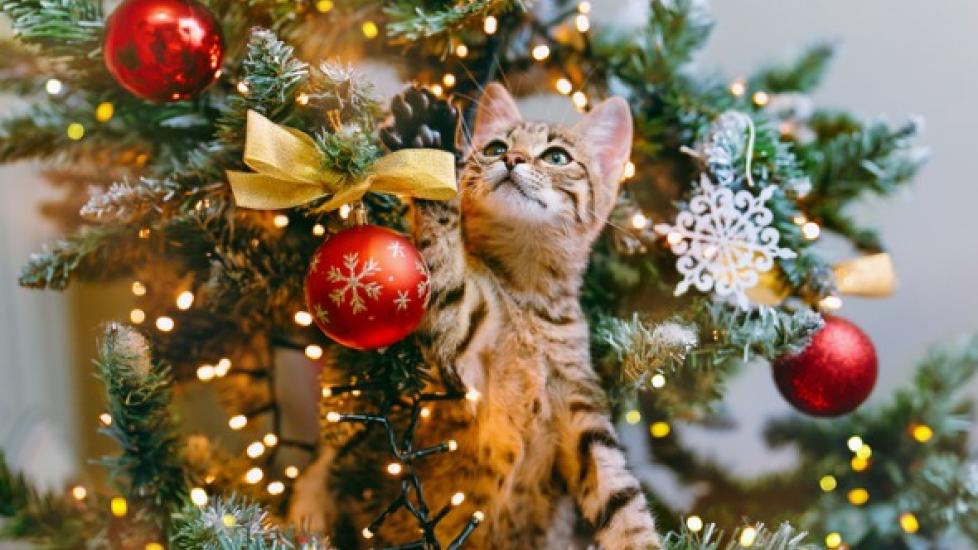Are Christmas Trees Toxic to Cats?
As we all know, cats are curious creatures. They will take the liberty to investigate any new item that enters your home, whether they’re invited to or not. So when the holidays come around, of course they want to explore the tree that seems like a great place to hide, play, and climb.
But how safe it is to allow your cat around the Christmas tree?
Are Christmas Trees Poisonous to Cats?
The most common type of trees that are used for the holidays are fir, spruce, and pine. The needles from these trees are all mildly toxic to cats if they eat them.
Needles can cause gastrointestinal upset and irritation to the mouth due to the oils. However, your cat would have to ingest a lot of them to cause severe toxicity. Fallen needles can also impact, obstruct, or even puncture the lining of the esophagus, stomach, and intestines, leading to severe illness.
Cats will also often lap up the water at the base of the Christmas tree, so it’s important to not use any additives to prolong the life of the tree. The most popular options—fertilizers, preservatives, sugar substitutes (especially xylitol), and aspirin—can be toxic and very harmful to cats. These can cause mild signs, such as belly upset, to severe signs, such as seizures, liver, and kidney issues.
If you do use water additives, get a covered tree base or block off your cat’s access to the tree entirely to avoid ingestion.
Other Christmas Tree Safety Hazards for Cats
The tree itself is not the only concern when it comes to Christmas cat safety. Here are some other dangers to be aware of:
Decorations
Decorations can be even more detrimental than the needles or the water to our feline friends. Ornaments, especially glass ones, can cause choking hazards or lacerations to the mouth and gastrointestinal tract if they fall and shatter. The fragments can also cause blockages or perforations in the intestines or stomach, which can only be treated with surgery.
Tinsel and garlands are also hazardous to cats if ingested. Long, thin, string-like materials such as these often lead to obstruction of the gastrointestinal tract.
One piece of tinsel may get stuck under the tongue, and then the other end continues to move through the esophagus and stomach and into the small intestine, causing a blockage. This tiny, string-like decoration can become sharp and cut through the intestine once this occurs. Surgical removal and repair is the only treatment. Sometimes, sepsis or generalized infection occurs if there is an intestinal perforation.
Lights and Electrical Cords
Christmas lights and electrical cords are major hazards if chewed, as they can cause shock that results in burns, heart arrhythmia, trouble breathing, and even death.
How to Create a Cat-Safe Christmas Tree
Just because there are certain dangers for cats doesn’t mean you can’t have a Christmas tree. Here are some tips for keeping your cat safe around the tree throughout the holidays.
- An artificial Christmas tree can help you avoid the dangers of water additive/tree needle ingestion. However, you will still need to be cautious, since chewing plastic or aluminum can still lead to oral irritation as well as blockage of the intestines if pieces are ingested.
- If you want a real tree, try finding a “non-drop” option such as a Nordmann Fir. These trees tend not to drop their needles like other live Christmas tree options.
- Partitioning off the entire Christmas tree can be difficult, and not the most elegant choice. However, you can try blocking off the tree with a cat pen or gate to keep your cat out.
- Using a heavy tree base or attaching weights to the base can help keep your kitty from knocking it over. You could also attach the tree to the wall to avoid toppling.
- Try spraying diluted vinegar or deterrent sprays around the base of the tree, which taste bitter to cats. Some cats will even recoil at the scent of these sprays. These will need to be reapplied, as the scent or flavors will fade.
- Motion-activated pet-deterrent air sprays can detect movement up to several feet away, triggering the release of a hiss of air. These air sprays can be placed at the base of the tree to discourage cats from getting too curious.
- Use battery-operated tree lights and hide the battery pack in the tree itself to help lessen this risk of electrocution. Also, make sure to tie up all extra wires and electrical cords to avoid easy access to danger.
Overall, if you are not able to keep your cat safe around your Christmas tree no matter how you try to safety-proof it, you should keep your cat out of the room where the tree is kept. Too many injuries can occur, and this is the best way to keep your cat happy and healthy during the holiday season.
Featured Image: iStockphoto.com/ Siarhei SHUNTSIKAU
